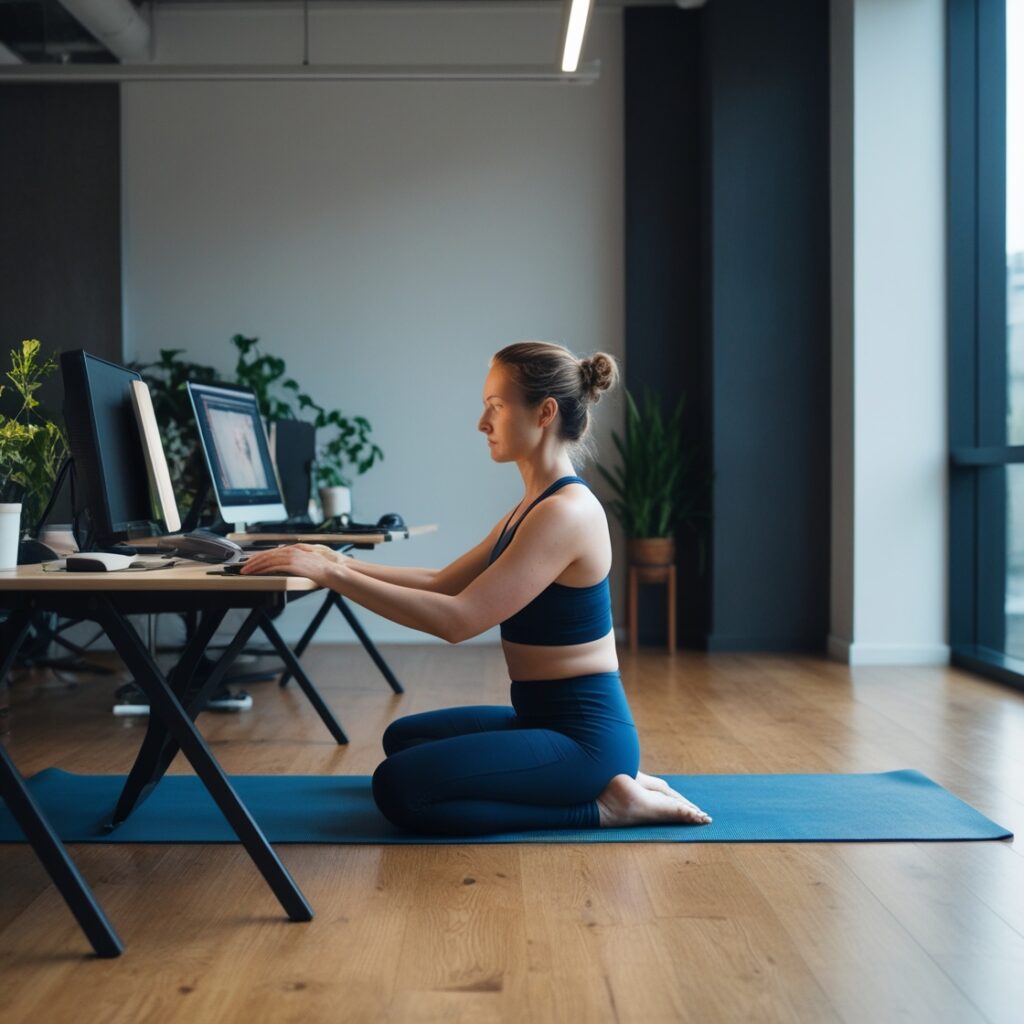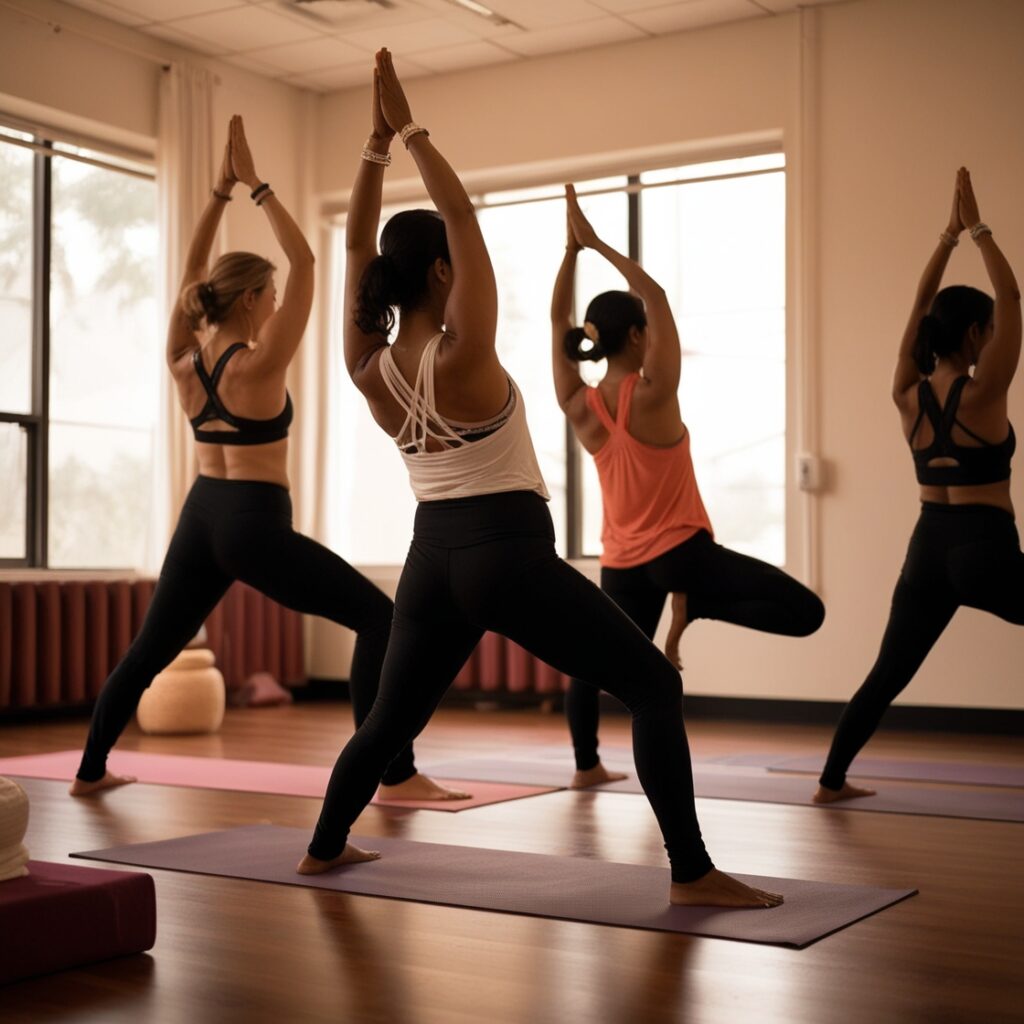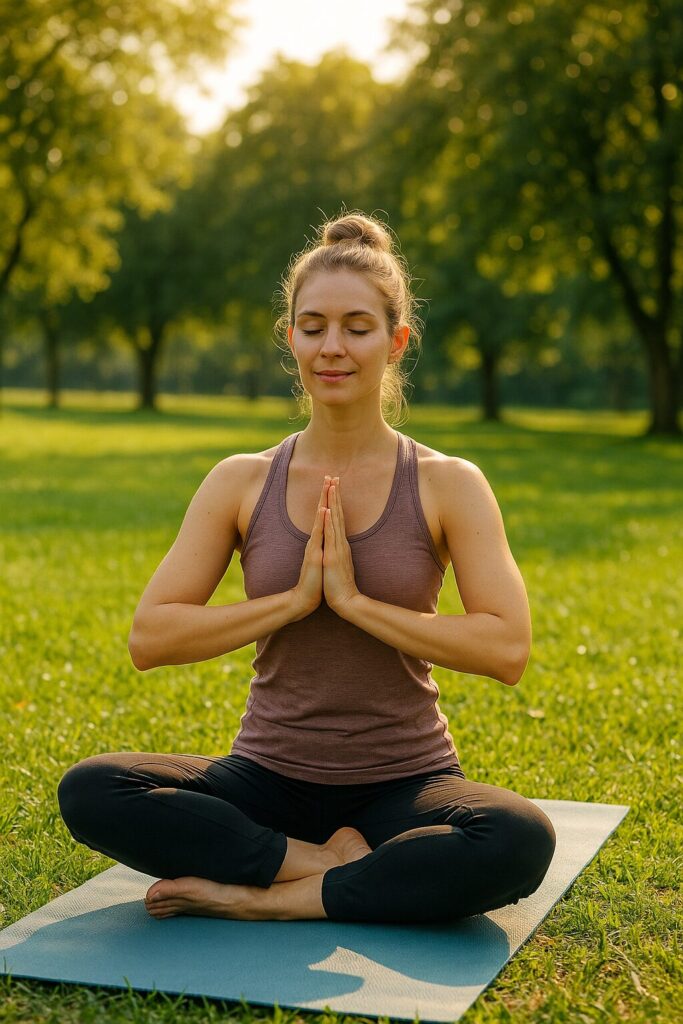Meditation has become an essential tool for leading a peaceful life. In this fast-paced world, people are trying to become peaceful in their lives but feel it is impossible. That’s where meditation comes in – a simple and easy tool to reconnect with your inner self, reduce stress, and boost mental clarity. Meditation is the only solution to provide you with a peaceful life. In this blog, we’ll delve into what meditation or Dhyana Yoga is, its proven benefits, and practical tips to get started.
 Introduction:
Introduction:
Meditation Definition:
In the Srimad Bhagavad Gita, meditation is referred to as “Dhyana” or broadly speaking as “Dhyana Yoga”. It is a practice of focusing the mind and attaining a state of deep contemplation and spiritual awareness. The Gita describes different aspects of meditation and its significance in attaining self-realization and union with the divine. Here is an important teaching on meditation from the Bhagavad Gita: In Chapter 6/10 (Abhyas Yoga ) of the Bhagwat Gita it has been mentioned :
“yogī yuñjīta satatam ātmānaṁ rahasi sthitaḥa
ekākī yata-chittātmā nirāśhīr aparigrahaḥ”
This means those who seek the state of Yoga should reside in seclusion, constantly engage in meditation with a controlled body and mind, and get rid of desires and possessions for enjoyment.
1. How do we start Meditation?
A favorable lifestyle is an essential aspect. Our minds are always busy thinking about different things that restrict us from meditating. Following the suggested steps after adjusting the lifestyle which makes meditation feasible with some perseverance. The rewards are so great that everything is worth it. Now, how do we start?
Following are some important steps to be kept in mind:
i. Selection of Place: While choosing a place, it should be kept in mind that the place should be quiet, clean, and uneven. Therefore, it is advisable that the place should be away from your home where there will be no hustle and bustle, the place should be clean so that there is no obnoxious smell and fear of insects and reptiles that may hamper attention and the place should be uneven so that there is no fear of falling down.
ii. Dresses while practicing: The most favorable dress should be comfortable, easy to move, and maintain tranquility. It should be made up of cotton or silk so that there is no irritation in the body and keep the body cool. Should not be tight fitting to avoid any type of discomfort during prolonged sitting. Some people prefer ritualistic dresses such as dothi, kurta, or kaftans. Yoga pants or leggings are also widely favored.
iii. How to sit: The sitting posture should be in Lotus pose so that the body will be straight. Keep your legs crossing each other and foot should be resting on each other. The thorax, head, and neck should be in a parallel line and the eyes should be fixed at the nose tip. Now, position your hands in Dhayana Mudra, placing palms one above the other. Close the eyes gently to block any distractions or keep them slightly open.
iv . Relax and start Pranayama: Now, start Pranayama (Breathing exercise). Start deeply inhaling (counting should be there, viz 6 seconds) hold it for 6 seconds, and exhale within 6 seconds. Continue for 5-10 minutes without any discomfort. But, should be practiced regularly, at a fixed location, on the same sitting arrangement and timing should be fixed as per your convenience.
v. Mindfulness: Pay attention to your breathing. If your mind wanders, gently bring your focus back to your breath. It’s natural thoughts to come and go. Accept them without judgment and return your focus to your breath.
vi. Duration: Start with a few minutes and gradually increase the time as you become more comfortable. 5-10 minutes of daily practice can be beneficial. Over time, you can extend your session to 20-30 minutes or more.
2. What should we do to start it: Moderation is required in all areas of life, including eating, sleeping, working, and enjoyment. When we sit for practice, too much eating, too little sleep, too much exercise, and not enough entertainment will make us feel exhausted and drowsy. Too little food, too much sleep, too little exercise, and too much entertainment all dull the mind and prevent us from being able to concentrate on anything.
Here, moderation is advised. While taking your food, it is always to be kept in mind that you should take your food 2/3rd, 1/3 of water, and the remaining 1/3 for air space so that proper digestion takes place. Based on what keeps us attentive and concentrated during meditation, we must determine the appropriate quantity for us. We ought to live structured, disciplined lives. To help us get our to-do lists off of our minds when meditating, we should establish a method that is completely spelled down. If we don’t have this, we’ll be worried about what to do. When we practice, they will keep our thoughts busy and prevent us from losing them.
3. What are the different types: There are different types of meditation in vogue but we generally follow the Chakra type and Spiritual type. In the Chakra type, we can balance the seven Chakras by thinking or visualizing the seven chakras with chanting mantras or pranayama. This is the best of all the other types of meditation. This improves emotional balance, energy flow, and spiritual well-being. The other meditations are:
- Mindfulness type
- Transcendental type
- Guided type
- Loving-kindness type
- Vipassana type
- Zen type
- Yoga type
- Focused attention type
- Body Scan type
- Movement type etc.
By exploring these types, you can consider what type of practice resonates best with your needs and lifestyle. Each type offers unique pathways to mental clarity, emotional stability, and spiritual growth
4. What are the benefits of Meditation: This is a simple yet profound practice that can benefit both the mind, body, and soul. If you’re looking to reduce stress, improve focus, or enhance your overall well-being, making it a part of your daily routine can lead to transformative results. Some of the benefits are given hereunder:
- Stress reduction
- Improve focus and concentration
- Better emotional health
- Enhance self-awareness
- Reduce age-related memory loss
- Improve sleep quality
- Pain management
- Boost immune system
- Promote kindness and compassion
- Support overall physical health
These abovementioned benefits can vary from person to person, and the effects often become more pronounced with regular practice. If you’re looking to reduce stress, improve focus, or simply find a moment of peace in your day, it can be a valuable tool.
5. Why this is a powerful tool: In today’s world this has become a powerful tool because it aligns the inner world with outer actions. It offers a way to find balance, peace, and purpose amidst life’s chaos. With consistent practice, it becomes more than a tool—it becomes a way of life, unlocking your full potential.
People around the world, irrespective of their age tend towards meditation. Every people face pressure right from academics to social to professional leading to heightened stress, anxiety, and burnout. Meditation has gained traction as an accessible solution to these problems, an effective tool for mental clarity and self-care.
6. What is Meditation according to the Bible: In the Bible, it often refers to deeply contemplating or reflecting upon the words and teachings of God. It’s not so much about the practice of sitting silently or focusing on the breath, as in some other meditation traditions, but about engaging the mind and heart with Scripture and spiritual truths. Here are a few key aspects.
Biblical Meditation:
- Reflection on Scripture:
- Psalm 1:2 says, “But his delight is in the law of the LORD, and on his law he meditates day and night.”
- This verse emphasizes the importance of consistently thinking about and contemplating God’s Word.
- Contemplation of God’s Works:
- Psalm 77:12: “I will meditate on all your works and consider all your mighty deeds.”
- This points to the practice of remembering and reflecting on God’s actions and creations.
- Quiet and Thoughtful Reflection:
- Psalm 46:10: “Be still, and know that I am God.”
- This encourages believers to quiet themselves and focus on God’s presence and sovereignty.
- Prayerful Meditation:
- Joshua 1:8: “Keep this Book of the Law always on your lips; meditate on it day and night, so that you may be careful to do everything written in it. Then you will be prosperous and successful.”
- This emphasizes the connection between meditating on Scripture and living a life in accordance with God’s will.
- Spiritual Growth: It helps believers grow closer to God and understand His will.
- Renewal of the Mind: Romans 12:2 speaks of the renewal of the mind, which can be facilitated by meditating on spiritual truths.
- Guidance and Wisdom: Through meditation on God’s Word, believers seek guidance and wisdom for their lives.
Biblical meditation is about filling the mind with God’s Word and allowing it to transform the heart and mind. It’s a practice of focusing on God’s teachings and applying them to daily life.
7. Conclusion: Meditation is a transformative journey toward overall well-being, encompassing mental clarity, emotional balance, and physical health. Regularly practicing mindfulness can reduce stress, enhance focus, and foster inner peace. This ancient practice is accessible to everyone and requires no special tools, just a commitment to self-care. Start integrating meditation into your daily routine today and experience the profound benefits it can bring to your life. Embrace this journey and invest in your well-being—your mind, body, and soul will thank you.
My unique experience: From my experience at the early stage of practicing, I placed a square Photo of my Guruji in front of me and fixed my eyeballs on his lotus feet as long as I could see without dropping off my eyelids. SunndenIy I saw his photo was revolving like a wheel, sometimes it became bright and sometimes it became dim and I concentrated my mind as much as I could see on that Bright Light for a longer time for my satisfaction and that was my Grace. Are you ready to begin? Take a few moments now to close your eyes or fix your eyeball on a particular object, breathe deeply, and start your meditation journey.
FREQUENTLY ASKED QUESTIONS:
- Question: Will meditation increase focus?
Ans: Yes, meditation can increase focus. Studies show that regular meditation practice can improve attention and concentration. Practicing meditation consistently can lead to better control over attention and a heightened ability to concentrate on tasks, making it a valuable tool for improving focus.
- Question: Why is meditation necessary?
Ans: Meditation is necessary because it extends numerous mental and physical health benefits. It reduces stress, anxiety, and depression by promoting relaxation and emotional balance. Moreover, meditation can decrease blood pressure, improve sleep quality, and boost the immune system. By adopting meditation into daily life, the practitioner can achieve overall well-being and a more balanced and fulfilling life.
- Question: Which meditation is best?
Ans: The best meditation depends on individual needs. Mindfulness meditation is excellent for focus and stress reduction. Pranayam with meditation is the best way for self-realization. Choose your preferred method that aligns with your goals and preferences for the most effective results.
- Question: Which meditation technique is best for sleep?
Ans: Guided meditation and mindfulness meditation are best for sleep. These can help relax the mind, reduce stress, and promote a calm state, making it easier to fall asleep fast.
- Question: Where does meditation originate?
Ans: Meditation originated in ancient India. Later it became a central practice of Buddhism. The earliest records of meditation come from the ancient Indian scriptures known as the Vedas, Shiva Samhita, and Gheranda Samhita which date back to around 1500 BCE.
6. Question: Should I meditate before or after eating or drinking?
Ans: As per the Srimad Bhagwad Gita, meditation should start at dawn so that there is no noise or any disturbance. Therefore, eating is not permitted before meditation or after meditation. Drinking is permitted after half an hour of meditation.






